The Outsider Art Fair of 2007
by Gordon Fitch

Outside the Outsider Art Fair (1)
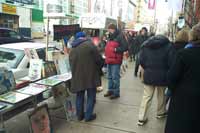
Outside the Outsider Art Fair (2)
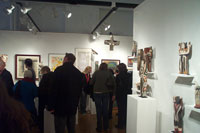
Inside the Outsider Art Fair (1)
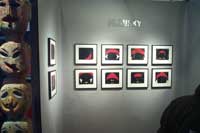
Inside the Outsider Art Fair (2)
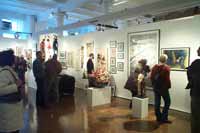
Inside the Outsider Art Fair (3)

Outsider Art Fair: Visitors Study Von Bruenchenhein Paintings
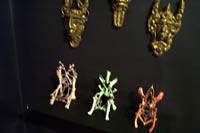
Outsider Art Fair: Von Bruenchenhein Chicken-Bone Chairs

Martín Ramírez: Horseman (mixed media)
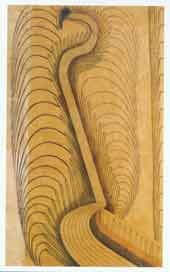
Martín Ramírez: Vertical Landscape (mixed media)

Martín Ramírez: Train, Tunnels (mixed media)
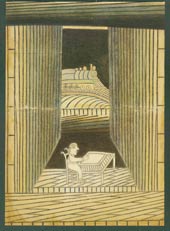
Martín Ramírez: Man At Desk (mixed media)
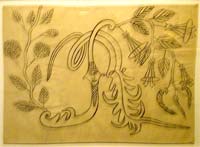
Martín Ramírez: The Letter I (mixed media)
The Outsider Art Fair is one of a series of thematic fairs for art works put on by Sandford Smith and Associates. The yearly Outsider Art fairs have been semi-famously called "an annual dose of smelling salts" for the art world (by Roberta Smith in the New York Times). This seems a bit overwrought in this era of postmodernity, however; what can be possibly considered "outside" the realm of artistic practice is becoming ever more recondite, a thing that is less and less visible the more sought-after it becomes. Everyone is offering smelling salts, and there was little in this exposition that would not have been at home at such venues of the avant-garde as PS/1. On the contrary, to some extent Outsiderness might conceivably give the less grandiose and shocking sort of artist a sort of niche in which his art might be taken seriously; or it will, should the present passion to épater one's bourgeois self recede somewhat.
The star of this year's production was unquestionably Martín Ramírez, a Mexican immigrant who was locked up in California for many years as a psychotic and who there produced about 300 surviving works of art. (Confinement to a mental institution is not an absolute requirement for qualification as an Outsider, but it is a major plus.) Near the front door, The American Folk Art Museum (of whom more below) had a booth advertising the current display of his work, and at least two of his exhibitors had pieces by him. In general, though, I think Ramírez has moved up a notch to a higher realm, along with Wölffli, Darger, and a few others, treasured by collectors and ready for artistic prime time, and thus unlikely to show up at three- day fairs in the Puck Building in the future.
The next best-represented big name of Outsiderness was probably von Bruenchenhein, several of whose paintings and Cornellish chicken-bone chair sculptures were present. He, too, is almost over the line toward the higher realms.
Whereas with von Bruenchenhein and Ramírez Outsiderness leads in the direction of Modernism, and the artists are classed as Outsiders more because of their personal histories and choice of media than the content of their work, there are many others who go in the direction of folk and primitive art, or art brut for those who prefer the tang of French. There was a good deal of that on hand, but I felt that most of it was undistinguished, especially the more recent. For a really brut piece of Art Brut to be taken seriously, rather than dismissed as inept, a certain context, a certain situation, is usually necessary. Thus a crude and not very interesting pair of slit goggles become a crucial technological record when we learn that they were made by the Innuit in 1740. Crudity alone does not make brut. Inevitably, the Outsider Art Fair decontextualizes its corresponding sort of art work and resituates it in trendy, hip, world-class, rich, bobo, postmodern New York City. For many objects this is very harsh spiritual treatment and they lose something of the power they might once have had.
In regard to this, there is a considerable problem for a person who wants to be an Outsider, since any normal step such as going to art school, trying to get one's work into a gallery, or even attempting to learn and apply traditional skills to one's work threatens disqualification, while at the same time those who have been to art school and avoided incarceration have trampled all over the wonted territory of the Outsider with regard to materials, subject matter, and style of execution. However, one can be sure this won't stop people from trying. Indeed, a few living and unincarcerated Outsiders risked presence at the Fair.
Amusingly, and probably inevitably, the Outsider Art Fair has spawned an Outside of the Outside in the persons of numerous sidewalk vendors who adorned the sidewalks and west fence of the Puck Building, creating a considerable jovial mêlée in front of the show along with its visitors. Like much that was inside the Fair, a lot of the more interesting work was very similar to what one might encounter on a visit to PS/1, and of course a lot of it was hastily-gobbed smears and junk piles hoping to find a tourist or two. However, the force-field of the Outsider Art Fair did seem to have mystically repelled the usual street-sellers of sad clowns, the World Trade Center, and Andy Warhol knock-offs, so the passer-by was at least spared these vacuities.
On the whole, the Outsider Art Fair, although maybe a little less brilliant than last year, remains an interesting show. I will be sure to return to it next year.
And now, on to 53d Street and the American Folk Art Museum, where Martín Ramírez's work was on display -- on four of its five floors, in great and generous abundance, the first comprehensive retrospective in 20 years according to the museum.
As noted previously, Ramírez spent the latter, artistic part of his life locked up as a psychotic in various institutions of the State of California; before that, he had had a little ranch in Mexico, and then, probably under financial pressure at home, had come to the United States to work at laboring jobs. Some contretemps had landed him in the custody of the State Police, with whom he did not care to converse. And so they locked him up in an asylum.
Apparently there is some dispute as to his biography and condition, which is noted in the placards which accompany the exhibition. Many people think he was not psychotic and should not have been confined; however, confinement is probably what enabled him to work on substantial pieces of art. Mexican ditch-diggers in 1930s California did not often enjoy this option.
As several critics have justly noted, the qualities that make Ramírez's work attractive are the same as those which make ordinary art works attractive at least to a pre-postmodern sensibility, allowing for a few eccentricities. They are coherent, rhythmical, focused, imaginative, and generally at least partially readable. The artist's drawing style has considerable verve and authority, and it is clear that a powerful design sensibility is at work. One recent critic thought Ramírez's talents would have made him the star of any art school he attended; I think this might be a bit excessive, but he would have been at least respected by his peers.
In terms of content, most of the works are fairly representational with strong abstract adornments. Usually, they are organized around a centralized figure, often that of a cowboy, seemingly on a stage, or a train, often leaving or entering a tunnel. The Madonna also comes in for exuberant treatment, probably influenced by the religious imagery in the Mexican churches of Ramírez's youth. There are as well some complex landscapes and some rather witty collages.
Needless to say, this content has led to all sorts of interpretation. The trains and tunnels especially beckon to latter-day Freudians. Perhaps everyone should try to be happy with his or her interpretations and fantasies; I won't argue with them.
Much to my surprise, off in a corner I found some drawings of alphabetic characters done by Ramírez, showing, I think, that, unlike many of his colleagues in the the Outsider category of asylum inmates, he was not merely illustrating peculiar inner narratives but was genuinely interested in form for its own sake.
For a good idea of what the show contains, see The American Folk Art Museum's page about the show, which contains several links to other reviews as well as a downloadable illustrated article made up of the texts of the wall placards (in PDF form) which will give a good idea of the show's content.
Some other recent articles about Ramírez and this show:
Roberta
Smith in the New York Times
Peter
Schjeldahl in the New Yorker
The Wikipedia entry for Martín
Ramírez
Text copyright © 2007 Gordon Fitch
Images courtesy of Sanford L. Smith, the Museum of American Folk Art, and the artists and exhibitors
 back to Contents page
back to Contents page